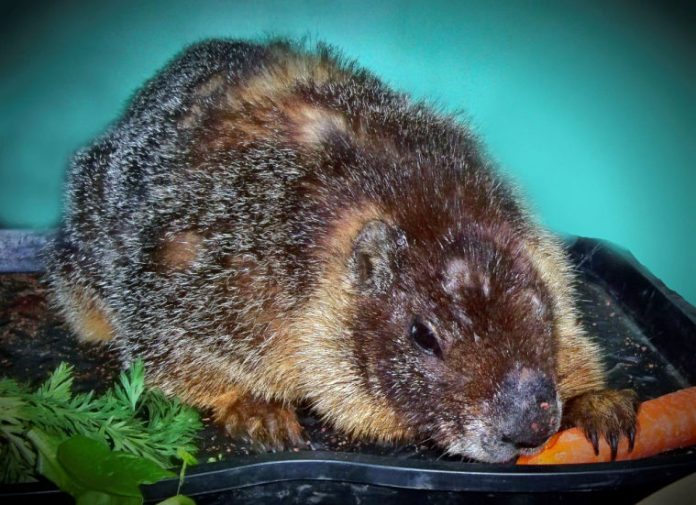As volunteers walked down the driveway after a day of feeding wildlife and cleaning enclosures at the Wildlife Education and Rehabilitation Center, they were mystified to hear an unusual whistling-chirping sound coming from underneath a parked vehicle. Getting low on the ground and peeking up under the car, they were astonished to see a large face staring right back at them. Looking and sounding like a super-sized ground squirrel (which in truth, it is), it turned out to be a yellow-bellied marmot, normally a denizen of the Sierra and Rocky mountains. We quickly learned why they’re nick-named “whistle pigs” – they whistle when alarmed by predators, such as wolves, foxes, coyotes, badgers, bobcats, golden eagles, hawks, owls, weasels, humans and dogs (one of which had just chased this particular marmot under the car).
Removing the 20-inch long critter was not a job for the faint-hearted. One needs special equipment to capture a frisky animal with large rodent teeth. Albert and Daniel, from the Santa Clara County Animal Control and Care, came to the rescue with nets, a catchpole and nerves of steel to grapple it from underneath the car and into a kennel. Cheers and high-fives all around!
After being sprayed as a precaution against fleas and other external parasites, the marmot, called a rock-chuck, was transferred to a large cage. He chowed down on a veritable chuckwagon of the best local organic veggies: kale, carrots with tops, dandelion greens, wheat grass, parsley and other fresh greens. In the wild, marmots are omnivores and forage on meadow grass, leaves, flowers, legumes, grains, fruits, berries, lichens, mosses, roots and insects.
Since marmots live at elevations of about 6,000 to 13,000 feet, much higher than the Bay Area, WERC did a little detective work and contacted neighbors who live nearby to see if anyone had recently visited the eastern Sierra. It was established that he most likely hitchhiked on a car from Sparks, Nevada all the way down to Morgan Hill – a 270-mile and five-hour-long trip.
It was critical to return the marmot to its original habitat, for genetic reasons and per California Department of Fish and Wildlife regulations. But just as staff was getting ready to sing John Denver’s “Country roads, take me home, to the place I belong,” there was a setback. Like the best laid plans of mice (side note: “marmot” is derived from a word that means “mountain mouse”) and men, the marmot’s planned release went astray. After six days fattening up at WERC and just one day before he was to be transported back home, he decided to go on the lam again. He had industriously chewed through a plastic cable, got out of the cage, dug under the enclosure and escaped into the woods. Because Morgan Hill is just not the optimal habitat for a marmot, we are trying to recapture him with a trap stuffed with his favorite greens. We’re keeping our fingers crossed that he will take the bait, so we can return him to his colony before cool weather returns and it’s time for him to hibernate in his burrow.
WERC has heard that several other marmots have been reported seen around the south county in the past month, and at least three of those have been caught and taken back to their mountain habitats. Apparently, this is becoming a rather common occurrence during summer vacation time, when people are driving further and leaving their cars while they hike and camp out. This is also happens to be the time when the diurnal marmots are most active and they are hungry after coming out of hibernation in spring. It’s a clash of cultures: The animals have found that vehicle innards make a tasty treat and/or comfy place to take a nap.
Unfortunately, not only might the marmot be injured or taken for a long, long ride, but oftentimes, the car owner returns to find his car needs towing and expensive repairs due to chewed up wiring, radiator hoses and brake lines. The park service now recommends that vacationers and residents put chicken wire around the bottom of their car when parking for an extended time within the marmot’s range.
The Wildlife Education and Rehabilitation Center rehabilitates native wildlife. It is supported solely by donations from businesses and the public. To contact WERC, call (408) 779-9372 or visit www.werc-ca.org.










